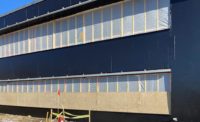Sequencing issues. Finger pointing. If you’re involved with the design or construction of exterior building envelopes you’ve experienced this before—either you’ve been called out by another sub or trade for damaging their work or perhaps you’ve been guilty of it yourself.
Perhaps nowhere is this more evident than the construction and continuity of the weather resistive barrier or air barrier control layers of the exterior building envelope. More often than not, damage caused to the WRB or air barrier is not done maliciously or intentionally; rather it is a matter of sequencing of the trades that come after the barrier is installed.
For example, continuous insulation—energy codes and smart building practice calls for an increased use of continuous insulation. This added layer needs to be attached and secured to the structure, yet it is typically sequenced after the air barrier/WRB is installed. Furthermore, the cladding of the building needs to be mechanically attached through the insulation, WRB/air barrier, sheathing, and back to the structure.
Both of these scenarios require fasteners and anchors that punch thousands of holes through even the most perfectly installed air and weather barrier. Perhaps the biggest challenge is that the damage caused is hidden behind the layer of insulation making it impossible to assess or fix the problem—this is often referred to as blind fastening. Rarely can this sequencing issue be resolved or avoided; hence the finger pointing game begins. There is an easy solution to this challenge: use fasteners and anchors that have been designed and tested to self-seal the blind fastener penetrations through the WRB and air barrier.
Fasteners Used in CI Systems
Mechanical attachment of rigid continuous insulation over sheathing and the WRB/air barrier is typically achieved with plastic washers and screws. There are several leading options available that do a fine job to secure the insulation, but very few that address the bigger challenge of maintaining continuity of the air and water control layers. An innovative solution is the addition of a semi-rigid urethane tube that is sized slightly longer than the thickness of the insulation, and fits snuggly around the screw. As the screw/washer combo is pressed through the insulation layer the tube also burrows through and bottoms out on the face of the air and weather barrier. As the screw drills through the sheathing and into the steel or wood stud substrate, the tube is then compressed between the underside of the plastic washer and the face of the insulation effectively sealing off the screw hole penetration of the water and air barrier.
This same tube fastener concept can apply to other common applications such as lath attachment for stucco and stone veneer over continuous insulation. This method can even apply to attaching hat channel over continuous insulation to which rainscreen cladding panels can be attached. Without the use of a sealing tube, every fastener penetration of the WRB/air barrier is susceptible to leakage.
Though there are many wall systems that have been assembly tested as per ASTM E331 water and E2357 air leakage tests, very few can pass much beyond the current bare-minimum code requirement of 6.24 psf pressure required to be considered an air barrier. With the addition of the sealing tubes, pressures beyond 25 psf can be achieved ensuring long term self-sealing capabilities despite even extreme weather conditions.
Types of Insulation
The attachment of mineral wool within the exterior building envelope creates its own set of challenges. Mineral wool is often specified for rainscreen applications due to its fire resistance, and often it is “tucked” between the girts and rails of rainscreen cladding attachment systems. Though the same plastic washers, screws, and sealing tubes mentioned above could work to attach mineral wool, often there is not a suitable substrate to secure the screw. For example, the clips of a rainscreen cladding attachment system are typically required to be secured every 16 inches horizontally at each steel stud location. The mineral wool will then need to be tucked between the vertically orientated clips creating a seam between each insulation panel at the only suitable substrate attachment point—not an ideal location to place a fastener as it could easily pull through the seam.
All too often, installers in this situation rely on stick pins to secure the mineral wool; however stick pins were originally developed for interior applications to insulate HVAC and air plenums. Relying on adhesion alone can cause big problems as the adhesive will eventually fail in the exterior environment and the insulation may sag or pull away from the wall which greatly reduces the effective R-value. A better solution is to use a mechanically attached impaling pin with gasketed screw that seals the penetration.
Masonry cavity wall construction poses similar challenges as masonry veneer anchors are required to anchor the veneer through the insulation and air/water control layers. This sequencing issue has the potential to create pathways for air and water penetration into the building envelope. Luckily, brick anchors have evolved over the years. Options are now available to address not only the structural requirements but also thermal performance, self-sealing ability of the blind anchor penetration, and the speed of installation.
Modern day brick anchors are made of unique materials including polycarbonate and stainless steel to reduce or eliminate thermal-bridging through the continuous insulation. Additionally, modern styles of brick anchors reduce tearing of the insulation and WRB by eliminating rotation of the anchor during installation. The polycarbonate tube presses through the layers while the screw inside spins and drills through the substrate and WRB/air barrier. This eliminates the tearing and chewing action associated with older styles of barrel style brick anchors that spin during installation.
Dual seals on modern masonry veneer anchors ensures sealing of both the face of the insulation, as well as the WRB/air barrier penetration behind the insulation.
Final Solutions
These solutions serve as examples of how the issue of sequencing multiple trades on the same wall can be alleviated through innovative and smart product design and selection. Rarely is the same subcontractor responsible for installing the air barrier, insulation and cladding—this lack of centralized ownership causes finger pointing both during construction and in the event of future leaks and litigation.
All parties in the industry from the building designer/architect to the distributors to the GC and sub trades share in the responsibility to create robust and energy efficient building envelopes. This is more easily accomplished when products are selected that alleviate the all-too-common and often unavoidable issues of installation sequencing.







Report Abusive Comment